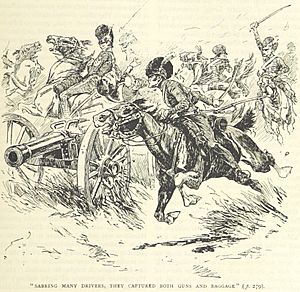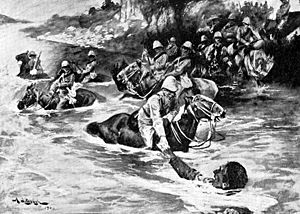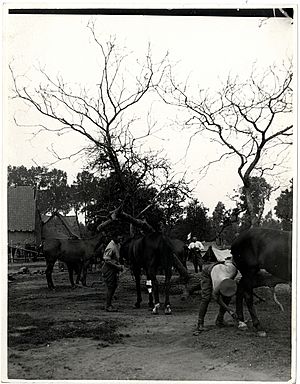13th Hussars facts for kids
Quick facts for kids 13th Hussars |
|
|---|---|
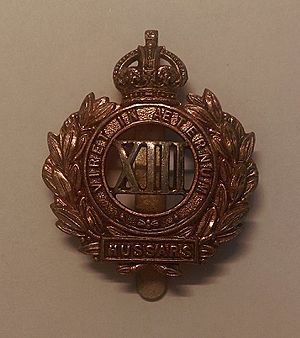
Badge of the 13th Hussars
|
|
| Active | 1715–1922 |
| Country | |
| Branch | |
| Type | Line Cavalry |
| Size | 1 Regiment |
| Nickname(s) | The Lily-Whites The Ragged Brigade |
| Motto(s) | Viret in aeternum (It Flourishes Forever) |
| Commanders | |
| Notable commanders |
Field Marshal Sir Robert Rich Major-General William Stanhope, 1st Earl of Harrington |
The 13th Hussars was a famous cavalry regiment in the British Army. It started way back in 1715 and was first known as the 13th Light Dragoons. This regiment served for over 200 years! They fought in big wars like the Napoleonic Wars, the Crimean War, and the First World War. In 1922, they joined with another regiment, the 18th Royal Hussars, to become the 13th/18th Royal Hussars.
Contents
The Story of the 13th Hussars
Starting Out: Early Battles
The regiment was created in 1715 by Richard Munden. It was called 'Richard Munden’s Regiment of Dragoons'. This happened because of a rebellion in 1715.
The regiment helped at the Battle of Preston in November 1715. After the battle, they took the rebels to prison. In 1718, the regiment moved to Ireland and stayed there until 1742.
During another rebellion in 1745, James Gardiner led the regiment. Many of the soldiers were new recruits. In September, a small group of Highlanders easily defeated them. This event was called the 'Coltbridge Canter'.
The regiment faced more trouble at the Battle of Prestonpans in September. This battle lasted only 15 minutes. Colonel Gardiner was killed. They also had a bad time at the Battle of Falkirk Muir in January 1746.
After this, Gardiner's replacement, Francis Ligonier, died from sickness. Philip Naison took over command. The regiment returned to Ireland in 1749. In 1751, it was renamed the 13th Regiment of Dragoons. They helped stop a small rebellion in 1781. In 1783, they changed to a "light" role, meaning they moved faster. A small group went to Jamaica from 1795 to 1798.
Fighting in the Peninsular War
In February 1810, the regiment sailed to Lisbon to fight in the Peninsular War. They took part in the Battle of Campo Maior in March 1811. Here, British and Portuguese cavalry fought French forces.
The 13th regiment, with about two and a half squadrons, charged a larger French cavalry group. They completely defeated them. The regiment then chased the French for seven miles.
However, Lord Wellington heard a simplified report. He thought the chase was too long and gave the regiment a harsh scolding. He even threatened to take away their horses. The officers wrote to Wellington, explaining what really happened. Wellington later said he would not have scolded them if he knew the full story.
The regiment also fought at the Battle of Albuera in May 1811. This was a very tough battle against the French army. The allies won only after very fierce fighting. The 13th Hussars were part of the cavalry force.
They also saw action at the Battle of Arroyo dos Molinos in October 1811. They fought at the Combat of Navas de Membrillo in December 1811. The regiment was also at the Siege of Badajoz in March 1812. They were part of the 2nd Brigade at the Battle of Vitoria in June 1813.
The regiment then moved into France. They fought at the Battle of the Nive in December 1813. They also fought at the Battle of Orthez in February 1814 and the Battle of Toulouse in April 1814.
The Famous Battle of Waterloo
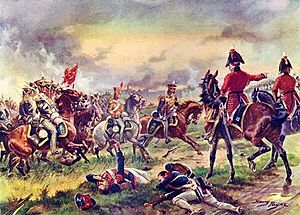
The regiment, led by Lieutenant-Colonel Shapland Boyse, fought in the Battle of Waterloo in June 1815. This was a huge battle where the armies of Duke of Wellington and Generalfeldmarschall Gebhard Leberecht von Blücher defeated Emperor Napoleon Bonaparte.
The 13th Light Dragoons charged many times during the day. They completely broke through a square of French infantry. An officer from the 13th wrote about their last charge. He said Lord Hill told them, "Drive them back, 13th!" The regiment followed this order perfectly.
The Crimean War and Beyond
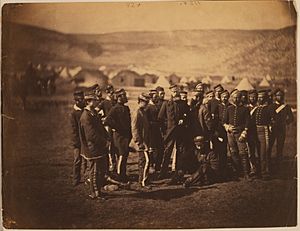
The regiment next saw action in the Crimean War. They were part of the light brigade at the Battle of Alma in September 1854. This brigade was led by Major General the Earl of Cardigan.
The 13th Light Dragoons were in the first line of cavalry during the famous Charge of the Light Brigade. This happened at the Battle of Balaclava in October 1854. The brigade rode through Russian artillery and charged into Russian cavalry. They pushed the Russians back but had to retreat because they didn't have enough soldiers. The regiment lost three officers and 38 men in this charge.
Lance-Sergeant Joseph Malone was awarded the Victoria Cross for his bravery during this battle. The regiment also took part in the Battle of Inkerman in November 1854. They had a small role there.
The regiment then helped with the Siege of Sevastopol in the winter of 1854. On April 8, 1861, the regiment was renamed the 13th Hussars. In April 1862, they started wearing hussar uniforms.
In September 1866, the regiment went to Canada to help with the Fenian raids. In January 1874, they sailed to India. Robert Baden-Powell, who later started the Scouts, joined the regiment in India in 1876. The regiment served in Afghanistan but did not see any fighting during the Second Anglo-Afghan War.
The Second Boer War
The regiment arrived in South Africa in December 1899. They fought in the Battle of Colenso during the Second Boer War. They also had a small part in the Relief of Ladysmith in February 1900.
The regiment stayed in South Africa until the war ended in May 1902. After the war, 556 officers and men of the regiment sailed back to Southampton in October 1902.
Fighting in the First World War
At the start of the First World War, the regiment was in Meerut, India. In December 1914, they landed in Marseille, France. They were part of the 7th (Meerut) Cavalry Brigade. They fought on the Western Front.
In July 1916, the regiment moved to Mesopotamia. They took part in the Second Battle of Kut in February 1917. They also helped capture Baghdad in March 1917.
Their last major action was the Battle of Sharqat in October 1918. At Sharqat, the regiment charged a hill where Turkish guns were located. They made a dismounted charge with bayonets and successfully captured the guns. The Turkish commander surrendered on October 30, 1918.
In 1922, the regiment joined with the 18th Royal Hussars. They formed a new regiment called the 13th/18th Royal Hussars.
Regimental Museum
You can find the collection of the 13th Hussars at the Discovery Museum in Newcastle upon Tyne.
Battle Honours
The regiment earned many special honours for their bravery in battles. These are some of them:
- Early Wars: Albuhera, Vittoria, Orthes, Toulouse, Peninsula, Waterloo, Alma, Balaklava, Inkerman, Sevastopol, Relief of Ladysmith, South Africa 1899-1902
- The Great War: France and Flanders 1914-16, Kut al Amara 1917, Baghdad, Sharqat, Mesopotamia 1916-18
See also



